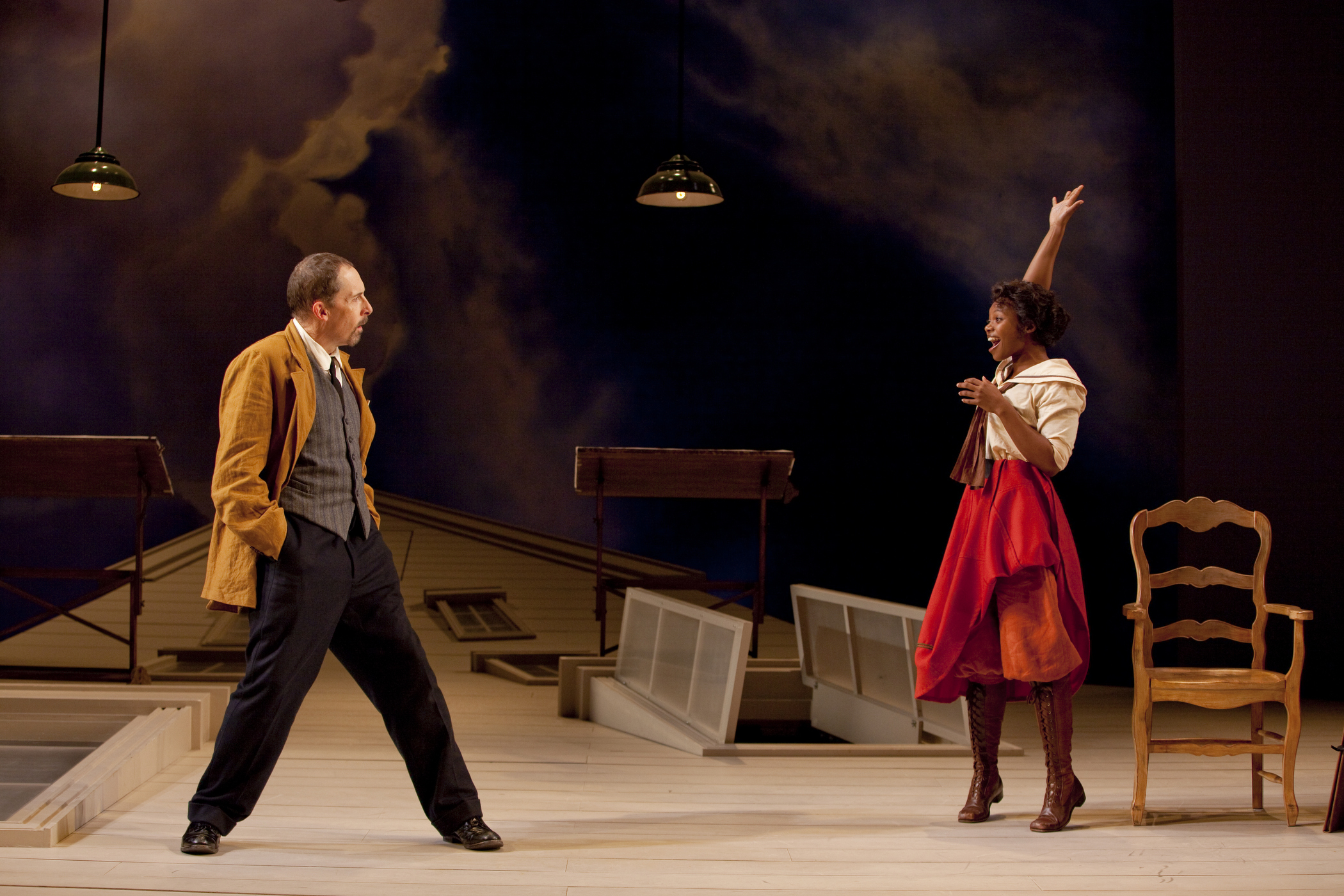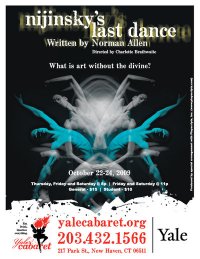 Henrik Ibsen’s dramas are classics of the theater, and his best-known plays lay bare the stultifying social mores of the late 19th century: A Doll’s House, Ghosts, Hedda Gabler. The later Ibsen, while still based in the naturalism of his main period, moves toward drama that is more symbolic, perhaps even allegorical -- dramas where the astute student of theater might see possibilities opening up for a new age of stagecraft.
Henrik Ibsen’s dramas are classics of the theater, and his best-known plays lay bare the stultifying social mores of the late 19th century: A Doll’s House, Ghosts, Hedda Gabler. The later Ibsen, while still based in the naturalism of his main period, moves toward drama that is more symbolic, perhaps even allegorical -- dramas where the astute student of theater might see possibilities opening up for a new age of stagecraft.
The Yale Repertory’s production of The Master Builder is gloriously evocative of the fresh face of contemporary theater. If the name of Ibsen brings to mind over-stuffed drawing-rooms with imperious stage-directions where neurasthentic types pine with Norwegian yearning, banish those thoughts at once. The set design by Timothy Brown is wide open, expressionistic -- the characters stand on a stage that seems to be the side of a house climbing into the heavens upstage -- and allows the actors to make full use of space as they ricochet off one another in an urgent ballet of feeling.
Given the theme of the rapturous climb to great heights -- both literal and figurative -- in the play, the set alerts us at once to the possibility for soaring above the quotidian that master builder Halvard Solness finds in Hilda Wangel, a young visitor from his past. Swept off her feet as a girl of thirteen when the mighty master builder climbed to the top of a high tower he designed to plant a victory wreath, she also insists he kissed her ‘many times’ when he found her alone later, and claimed he would come carry her off ‘like a troll’ to a kingdom in ten years’ time. The ten years are up, and Hilda wants her kingdom.
The Halvard Hilda finds is a driven man, but one who is also desperate -- worried about ‘the young’ who will make him step aside (particularly in the form of Ragnar Brovnik, an apprentice architect who Halvard ‘keeps down’ by not giving him any projects of his own), and preying upon youth by beguiling Brovnik’s fiancée, Kaia, so that she will remain in Halvard’s employ, thus giving Ragnar reason to stay. It’s an untenable situation that is beginning to fray and Halvard knows it, not least because Ragnar’s father, once Halvard’s superior, is near death and wants to see his son amount to something on his own before he dies.
Into this dense situation, Hilda arrives with the force of visionary destiny, suddenly inspiring Halvard with her muse-like presence and youthful attachment to his former grand figure, but also sharing in the confidences of past tragedy and loss in the Solness marriage, as well as learning of Halvard’s great burden of guilt. Can the master builder put all this aside and rise again to the glory he finds in her eyes?
As Halvard, David Chandler is as mercurial as the part demands -- at times, forthright and earnest, at times cold, unyielding and almost diabolical. He is tender about his wife, in her absence, but uncomfortable in her presence. He is direct with the doctor who tries to sound him out on his relation to Kaia, but is also arrogantly superstitious about his ability to control others through his own mind. Coiled with the exasperation of the man of talent beset by the demands of others, Mr. Chandler flings his expressive body all about the stage with the passion that Hilda brings to the surface. We see a man struggling, in almost every movement, to determine if his desires can overcome his misgivings.
And as Hilda, Susan Heyward is a thrilling delight. Girlish, willful, and remarkably quick on the uptake, Hilda, as written, could easily seem more sprite than person, a creature of Halvard’s Id suddenly incarnated in the flesh. As incorporated in Ms. Heyward, Hilda is nearly ecstatic with the force of her effect on her revered master builder, and plays with him through an intuitive grasp of what they might mean for each other. And though, as Ibsen not doubt intended, Hilda’s actual psychology remains a mystery, Ms. Heyward gives us every reason to believe in the spell that Halvard falls under in her presence -- a spell predicated on her unshakeable conviction of his greatness.
In the supporting cast, Felicity Jones’ Aline Solness is regal in a gorgeous black gown, displaying, with her mere presence, the sad memories that cling to the marriage, but also giving the dialogue a comic edge as the long-suffering wife all-too-knowing about her husband’s need for young, female devotees. And Slate Holmgren, as Ragnar, does much with a part that’s easy to overlook, particularly in his scene late in the play with Hilda, where, though she mocks him as a mere upstart, we can see in his self-possession possibly another master builder in the making.
Credit for this version’s success rests most securely, no doubt, on director Evan Yionoulis. In the “Talk Back” with the audience after the Saturday matinee performance, several in the cast spoke of her ability to ‘calibrate’ their performances to the right nuance -- and much of that nuance itself depends on the translation by Paul Walsh. The dialogue seems unforced and direct -- even when Solness and Hilda extemporize on Vikings and trolls (figures of baleful power Ibsen felt himself at times to be in league with) -- and sounds modern without straying into contemporary locutions.
And what does the play say to us now, more than a century and a decade after it was written? Ibsen’s strong presentations -- of a man of power abusing that power, of a man of talent seeking some new inspiration, of a man of years trying to revitalize himself, of a marriage that persists without ever freeing itself of its past, where tragedy, rather than ending the couple, made them what they are, and of a young woman’s seeming power to see the future and be the future -- never become dated. So, what do you see when the still striving, but slipping, figure climbs that tower in the end -- hubris? inspiration? despair? need? A struggle against time, against mediocrity, against God? Or a deluded effort to assert something whose day is done? Then ask yourself: what does Hilda see?
The Master Builder, by Henrik Ibsen. Translated by PAUL WALSH. Directed by EVAN YIONOULIS. Yale Repertory Theatre: September 18-October 10, 2009. Set design by Timothy Brown, costume design by Katherine Akiko Day, lighting design by Paul Whitaker, with sound design and original music by Scott L. Nielsen. Photograph© T Charles Erickson

 Henrik Ibsen’s dramas are classics of the theater, and his best-known plays lay bare the stultifying social mores of the late 19th century: A Doll’s House, Ghosts, Hedda Gabler. The later Ibsen, while still based in the naturalism of his main period, moves toward drama that is more symbolic, perhaps even allegorical -- dramas where the astute student of theater might see possibilities opening up for a new age of stagecraft.
Henrik Ibsen’s dramas are classics of the theater, and his best-known plays lay bare the stultifying social mores of the late 19th century: A Doll’s House, Ghosts, Hedda Gabler. The later Ibsen, while still based in the naturalism of his main period, moves toward drama that is more symbolic, perhaps even allegorical -- dramas where the astute student of theater might see possibilities opening up for a new age of stagecraft.